If you’re looking to take your running to the next level, learning how to run faster is crucial to that journey. Running faster not only improves your overall performance, but it can also help you hit new personal bests (PBs) and make your training and fitness regime more enjoyable.
By running faster, you can cover more ground in less time, which is especially beneficial if you’re training for a race, are strapped for time because of a busy schedule, or simply looking to improve your fitness.
Running faster also puts more stress on your body, leading to greater adaptations that can improve your endurance, strength, and cardiovascular fitness. Of course, there’s also more potential for picking up running-related injuries.
If you stick to the advice in this post, however, it should help you stay injury free by running smart and not overtraining! This post is in partnership with Nike.
If you’re looking for a supportive running shoe with enough cushioning and response to help you reach your goals of running faster or running longer; the Nike InfinityRN 4 is your perfect training partner. Read my in-depth Nike InfinityRN 4 review to learn more.
Learning how to run faster requires effort and commitment, but the rewards are well worth it, I promise.
I’m Alastair from Trail & Kale, and in this post, I’ll share several tips and techniques to help you increase your running speed and improve your overall performance.
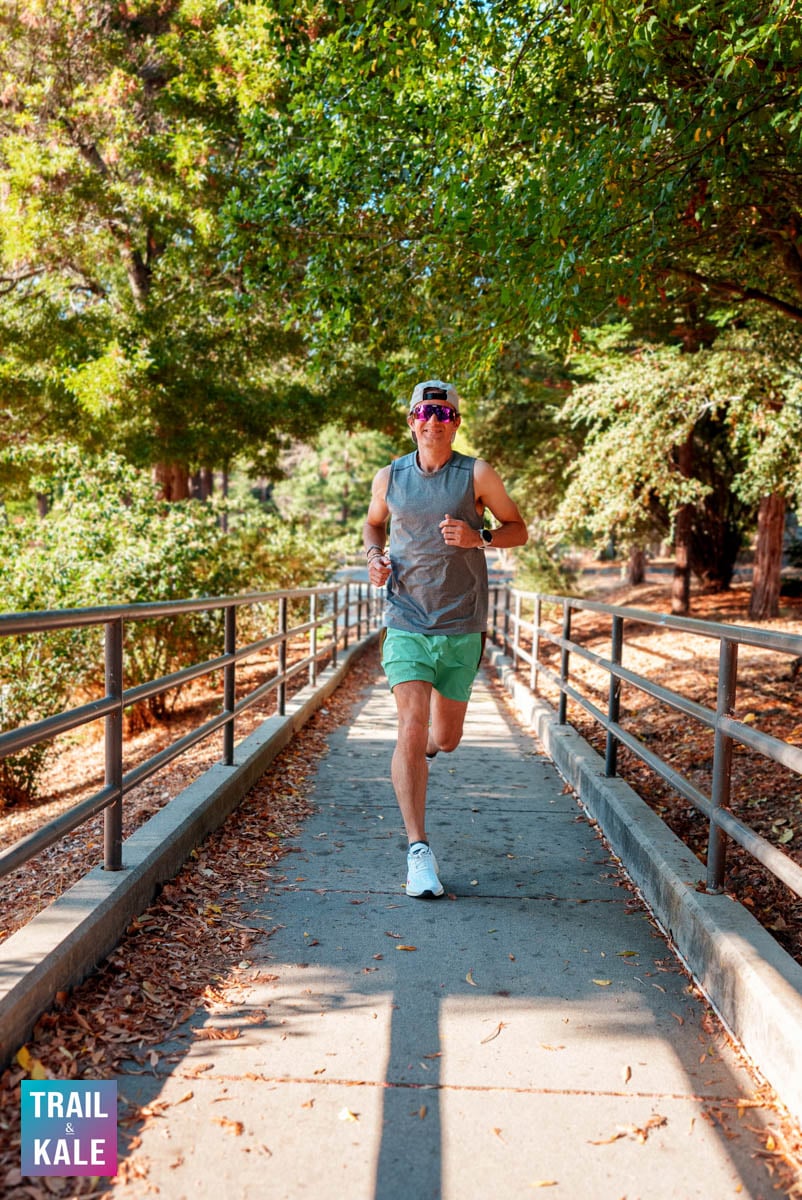
Topics covered in this article
In this post, I’ll cover a variety of tips and techniques to help you learn how to run faster. Starting with the importance of proper running form and how it can help you increase your speed.
Next, I’ll talk about interval training and the different types of workouts you can use to improve your running speed. I’ll then explore the benefits of strength training and provide some examples of exercises you can incorporate into your running routine to improve your overall performance.
Proper nutrition is also essential for running faster, so I’ll provide some tips for maintaining a healthy diet to support your training.
Consistency is the final key component of improving your running speed, so I’ll discuss the importance of sticking to a regular training schedule and some tips for doing so.
Before any run be sure to do proper dynamic stretching and then some statics stretches afterward – read our best stretches for runners after this post to learn our favorite stretching routine.
Ok, let’s get to it, here are my top 6 tips on how to run faster:
1. Proper Running Form will help you run faster
What ‘good running’ form actually means
Maintaining the correct running form is essential to improve your speed and reduce the risk of injury. When I refer to “running form”, I’m talking about the way your body is positioned and how you move while you run.
Proper running form is characterized by a straight and tall posture, relaxed shoulders, and an engaged core. Your arms should swing naturally by your sides, while your feet should strike the ground with a midfoot or forefoot strike, rather than a heel strike.
It’s also essential to maintain a consistent and efficient cadence, which is the number of steps you take per minute. An optimal cadence is typically considered to be around 180 steps per minute, although this can vary depending on your height, weight, and running style.
By focusing on maintaining proper running form, you can reduce the risk of injury and improve your running performance.
In our post about how to improve running form, we provide tips and techniques that can help you achieve and maintain the correct running form.
You may also want to read how to breathe while running, because how you breathe also affects how efficiently your body brings in oxygen to fuel your runs.
5 tips for improving running form
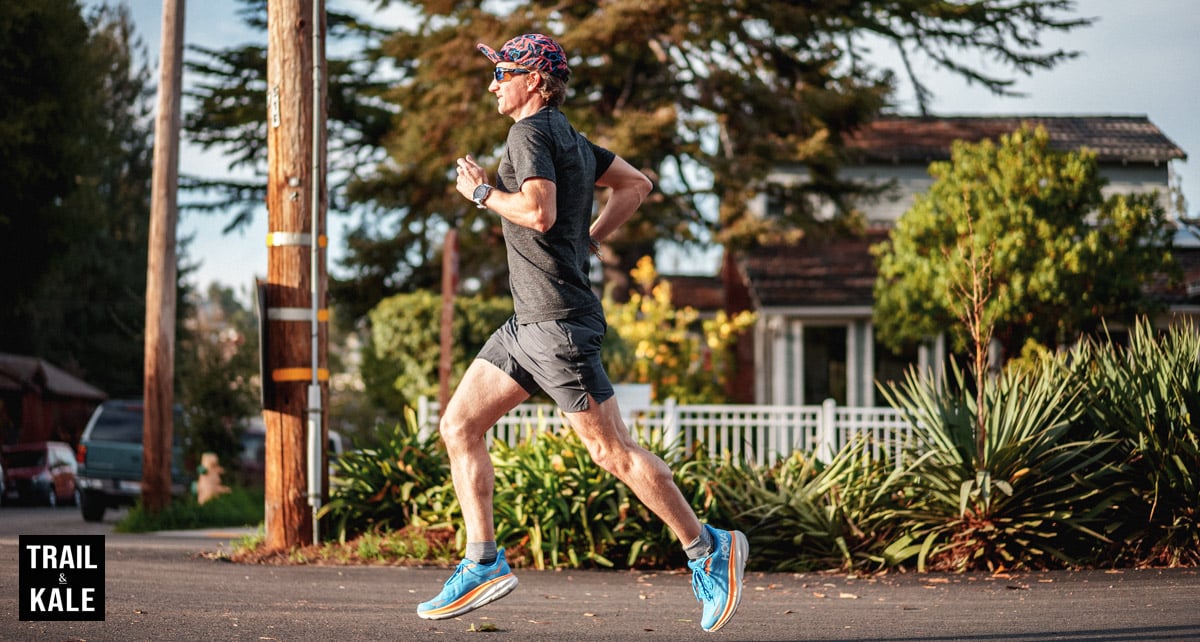
1. Focus on your posture
Keep your head up, and shoulders relaxed, and engage your core to maintain a straight and tall posture.
2. Relax your upper body
Focus on relaxing your arms, shoulders, and hands, allowing them to swing naturally by your sides.
3. Optimize your foot strike
Try to strike the ground with a midfoot or forefoot strike, rather than a heel strike, as this can help reduce the impact on your joints.
4. Maintain a consistent and efficient cadence
Aim for a running cadence of around 180 steps per minute, which can help improve your efficiency and reduce the risk of injury.
5. Be consistent by practicing regularly
Improving your running form takes time and practice. Incorporate these tips into your regular training routine and keep at it, and over time, you’ll notice significant improvements in your form and overall running performance.
2. Interval Training to increase running pace
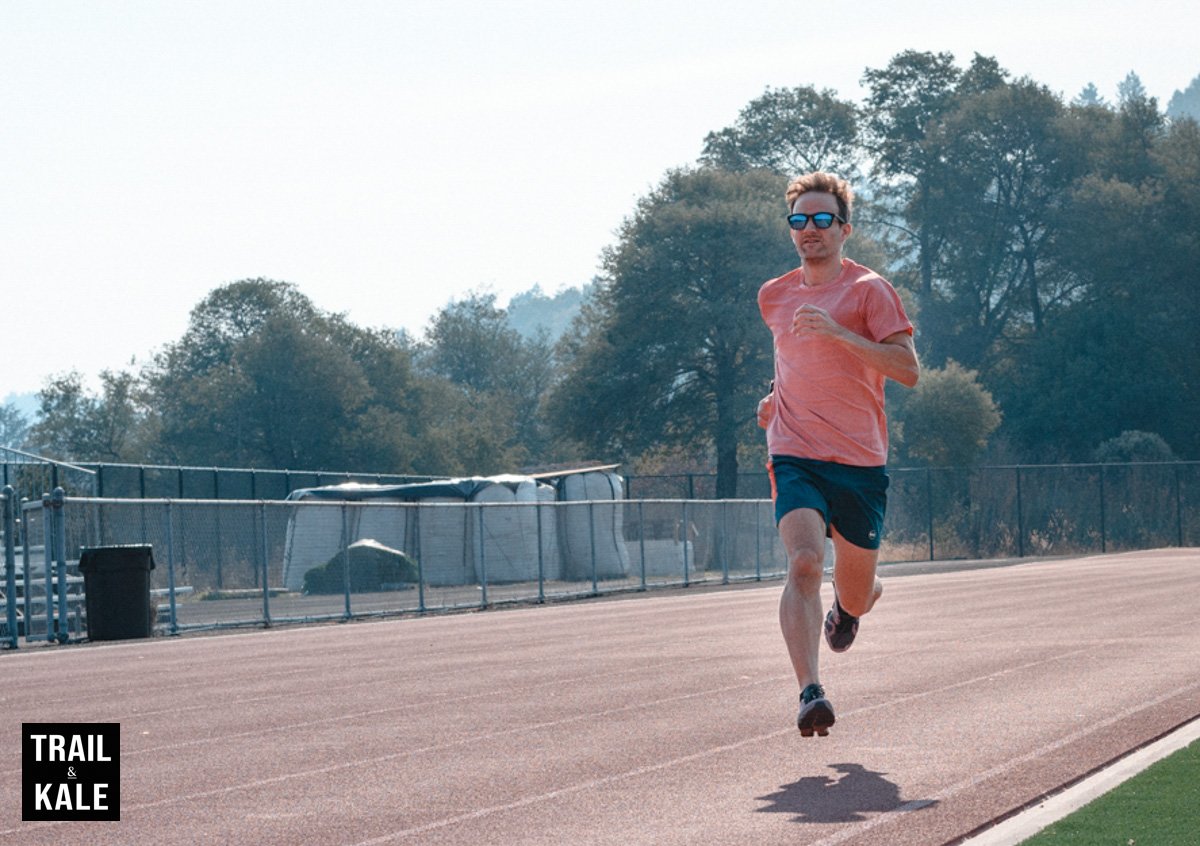
What is interval training?
Interval training (sometimes referred to as speed training) is a running technique that involves alternating periods of high-intensity exercise with periods of rest or low-intensity exercise.
Our post on interval training for runners explains how this technique can help you to improve your running performance by boosting your aerobic capacity, muscle endurance, and recovery time.
By incorporating intervals into your training plan, you can challenge your body in new ways and develop a more efficient cardiovascular system.
You can adjust the length and intensity of the intervals based on your fitness level and running goals. Whether you’re new to running or already an experienced runner, interval training can be a valuable tool to help you achieve your running goals.
How interval training can help you run faster
Interval training helps you run faster by improving your cardiovascular fitness, VO2 max, and lactate threshold.
The workouts increase your body’s ability to transport and use oxygen, which means your body can learn how to run faster and for much longer.
Intervals also help you become more efficient with your energy usage, which can help you run faster at any distance.
The 5 types of interval training
These are the 5 most popular types of interval training that runners can incorporate into their training plan to improve their running pace and performance.
When you’re doing intervals we strongly recommend you stick to the correct heart rate zones to ensure your effort levels are spot on, and that you get the most out of this high-intensity training.
These speed play techniques include:
1. High-intensity interval training (HIIT)
This involves short bursts of all-out effort followed by a period of rest. It’s a great way to build speed and power.
2. Fartlek training
This technique involves alternating periods of fast and slow running based on how you feel. It’s a more free-form type of interval training that can be done on any terrain. When running at your slower pace, you need to be slow enough to actively recover your heart rate.
3. Hill repeats
This involves running up a hill at high intensity, followed by a period of recovery. It’s a great way to build strength and power, and can be done on any hill or incline.
4. Tabata training
This is a form of HIIT that involves 20 seconds of all-out effort followed by 10 seconds of rest. It’s a highly effective way to boost cardiovascular fitness and endurance.
5. Pyramid intervals
This technique involves gradually increasing and decreasing the length and intensity of your intervals. It’s a great way to build endurance and speed together.
Tips for implementing interval training into your running routine
In our post all about ‘Interval Training For Runners‘, we have also shared 3x speed training workouts that you can use to incorporate speed workouts into your training schedule, so head over there next to level up your interval training knowledge and experience.
3. Tempo runs will make you faster
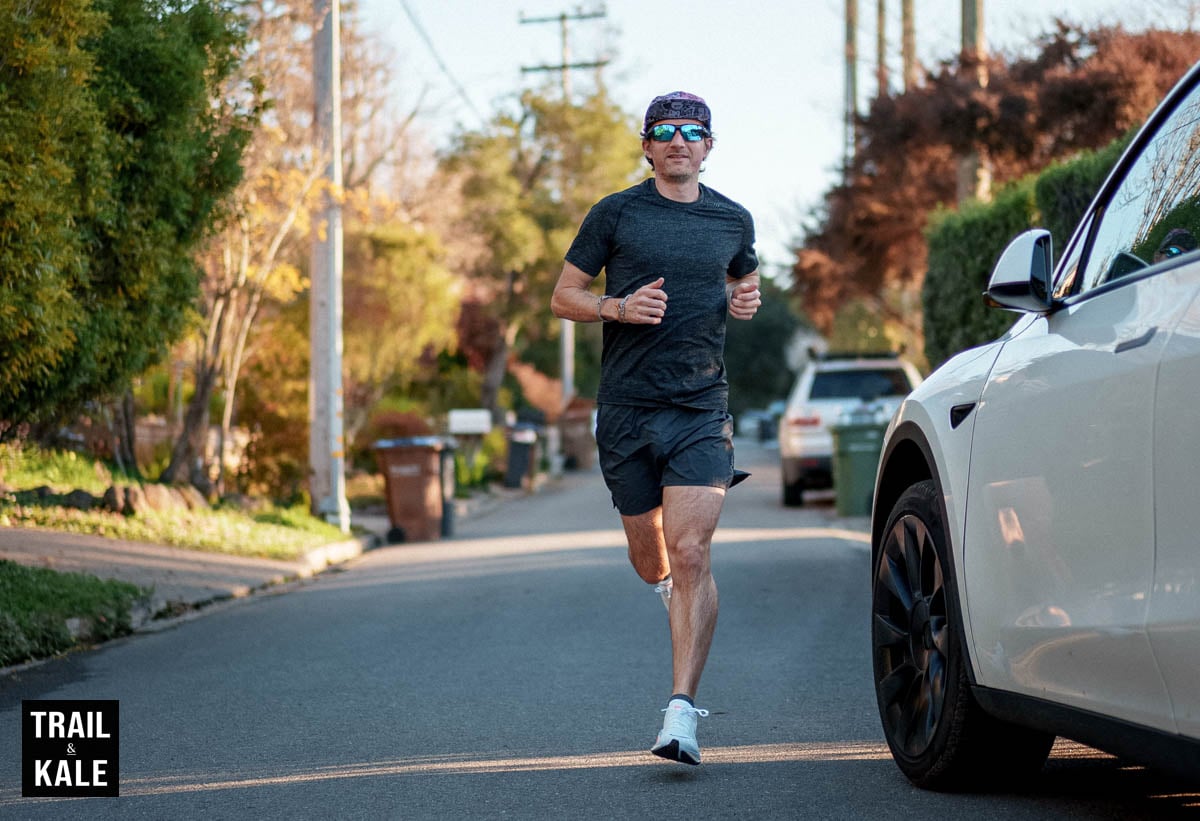
Tempo runs can make you faster by improving your lactate threshold, which is the point at which lactic acid starts to accumulate in the muscles during exercise.
By running at a slightly faster pace than your normal running pace for an extended period of time, you train your body to use oxygen more efficiently and delay the onset of lactic acid buildup.
This allows you to maintain a faster pace for longer periods of time without fatiguing, which translates to faster race times – it improves your ‘running economy’ for want of a better word.
Additionally, tempo runs can help build mental toughness and confidence, which are crucial for running faster.
4. Strength training for faster running
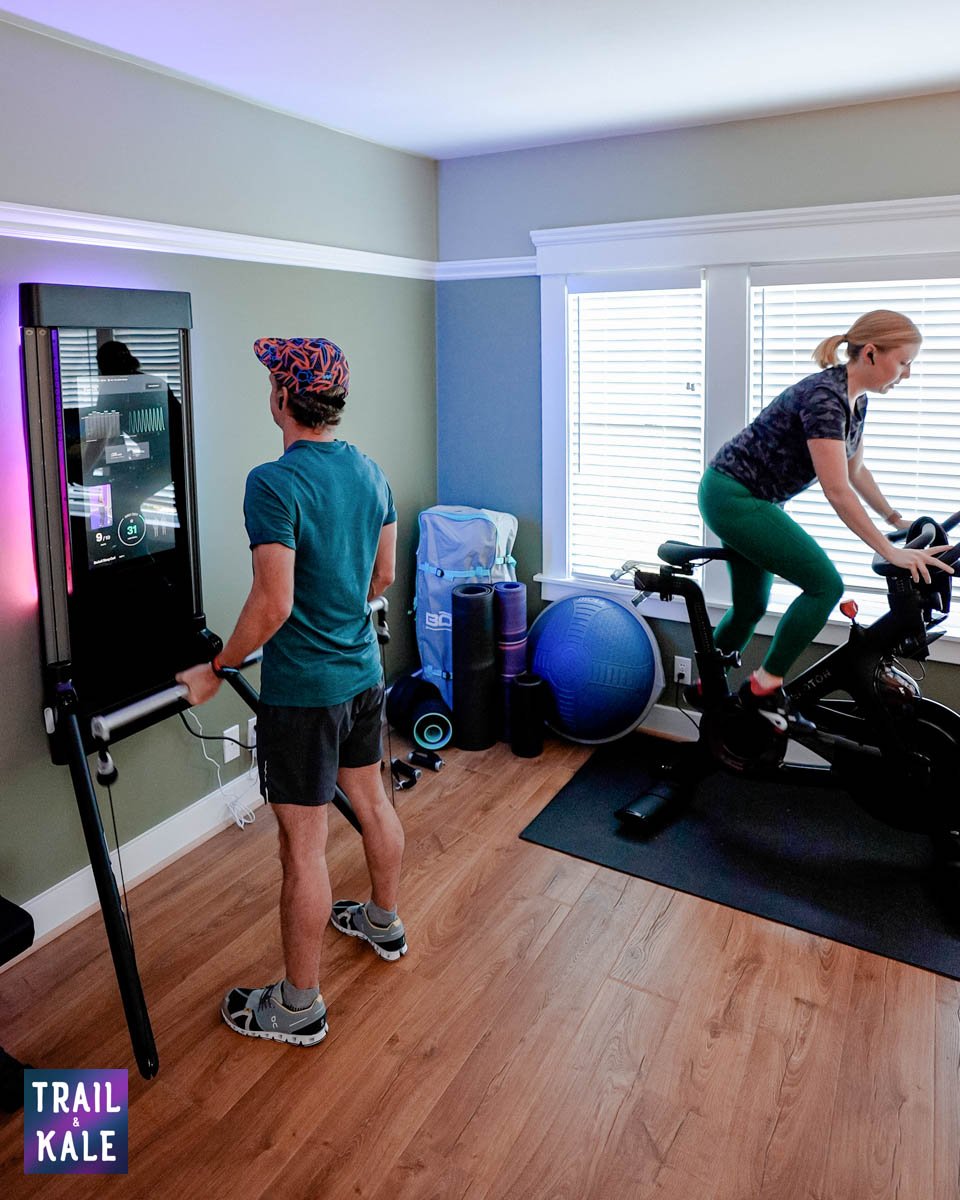
How strength training can help you run faster
Strength training helps you run faster by improving your power and speed.
Exercises like squats, deadlifts, and lunges (I’m a huge fan of split jump lunges) help you develop stronger leg muscles, which leads to more explosive power when you push off the ground. This translates to faster running speeds and more efficient use of energy.
Strong core muscles also help maintain proper running form, which can help you avoid injury and improve your performance.
Strength Training Exercises – Examples to try
Here are some examples of bodyweight strength training that you can incorporate into your run training (no gym equipment necessary):
In the above video, you can follow along as I do 5 of my favorite bodyweight strength exercises for runners that will increase strength in your core muscles and legs.
Do 20 reps of each exercise for a badass workout routine that will make you a stronger runner whether you run road or trail.
See how many circuits you can do in a row and save the video so that you can come back and repeat the exercises when you need some workout inspiration.
Watch out for the brutal burpees section, haha!
5. Proper Nutrition for faster running without the gut bombs
Why is nutrition so important for running performance?
Proper nutrition is essential for optimal running performance because eating the right foods provides your body with the energy it needs to power through a run, and also helps with recovery afterwards.
Complex carbohydrates and protein are important for endurance and muscle repair, while healthy fats provide sustained energy.
Hydration and electrolytes are also crucial for avoiding cramps and staying alert during a run. Consuming the right foods before, during, and after a run can improve your performance and will help you reach your goals.
Examples of foods to eat before and after running
As a general rule, what you choose to eat before morning training runs should:
- Provide slow-release energy (no huge sugar-driven energy spikes and lulls)
- Not be too heavy on the digestive system
- Be simple (and fairly bland)
- Be low in fat.
The following foods are some of our favorites to eat before running that have been tried and tested on everything from easy morning 5k runs through to getting you off to a good start for half marathon training, through to marathon training and even trail ultra marathon races.
- Oatmeal Porridge
- Whole grain toast or a bagel and nut butter
- Bananas
- Coffee – if it’s part of your normal morning routine
- Boiled potatoes with salt – also makes for a great mid-run snack on long runs
After your run, we recommend you eat high-protein foods, or even more conveniently, you can drink a protein powder mix.
The faster you’re able to recover, the more running you can do, which ultimately is the goal when training to become a better, faster, and stronger runner with minimal risk of overtraining injuries.
If you’re wondering when is best to drink protein shakes, it’s generally recommended that protein is consumed within the first hour of finishing a workout, intense run, or race.
We have also heard that it’s recommended that women should have protein within 30 minutes, while men have a 60-minute window for optimal muscle repair. So, basically, plan to drink a protein shake as soon as you can after your run!
Fueling during a run will help you maintain energy throughout
Running gels and Energy Chews are a popular nutritional supplements that many runners use to help improve their performance during long-distance running, ourselves included.
These gels are typically made up of simple carbohydrates, electrolytes, and sometimes caffeine (most useful to ultrarunners running through the night), all of which provide a quick source of energy for your body during exercise.
Here are some reasons why you may want to consider eating energy gels while running:
- They provide a quick source of energy: During long-distance running and marathon training, your body needs a constant supply of energy in order to keep going. Energy gels provide a concentrated source of carbohydrates and sugars that can be quickly absorbed by your body and used for fuel.
- They help prevent fatigue: Running for extended periods can be physically exhausting, and energy gels can help prevent fatigue by providing a steady stream of energy throughout your run and sometimes caffeine.
- They aid in hydration: Many energy gels also contain electrolytes like sodium and potassium, which help replenish the electrolytes lost through sweat during exercise. This can help prevent dehydration, muscle cramping, and improve your overall performance.
- They are easy to carry: Energy gels are typically sold in small, portable packets that are easy to carry in a pocket or running belt. This makes them a convenient and practical option for fueling during a run.
While energy gels can be beneficial for improving your running performance, it’s important to remember that they are not a substitute for a well-balanced diet.
It’s still important to consume a variety of foods that provide a range of nutrients to support your overall health and fitness goals.
Tips for maintaining a healthy and balanced diet
To learn more about how to maintain a healthy and balanced diet I recommend reading our post all about the benefits of a whole food plant-based diet, which by the way isn’t vegan.
We still eat fish and chicken from time to time, however many of our meals consist of mostly of plant based foods from the following plant food groups:
- Fruit (e.g. bananas, blueberries, oranges, strawberries)
- Vegetables (e.g. broccoli, carrots, cauliflower, kale, lettuce, brussels sprouts)
- Tubers & Starchy Vegetables (e.g. potatoes, corn, green peas, winter squash, sweet potatoes)
- Whole Grains (e.g. barley, millet, oats, quinoa, wheat berries, brown rice)
- Legumes (e.g. black beans, chickpeas, lentils, pinto beans)
- Seeds & Nuts (e.g. almonds, pine nuts, sesame seeds)
- Mushrooms
6. Consistency for faster running
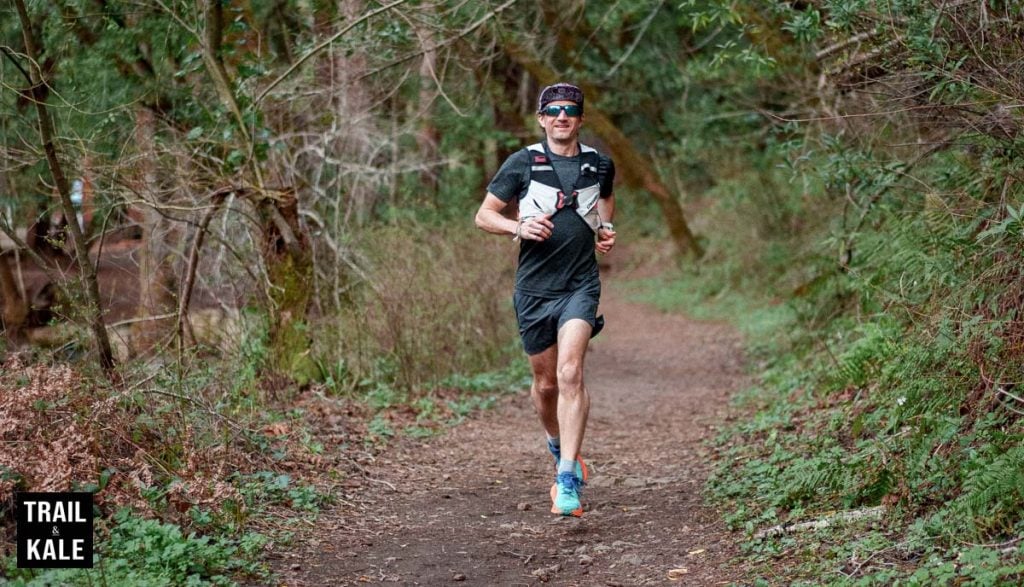
Consistency is key when it comes to building speed in running and fitness in general. Without consistency, it’s difficult to improve your fitness level, and as a result, your speed.
I’ve put this to the test a few times by putting myself on a self-prescribed running streak from time to time in order to accelerate my fitness gains and get myself race ready, fast :).
Regular training helps your body adapt and become stronger, making it easier to run faster. But consistency doesn’t mean running hard all the time – that would just lead straight to injuries and no runner wants that.
It’s important to have a balanced approach to training that includes easy recovery runs, speed workouts, and recovery days.
You also need to stick with your training plan and make adjustments when necessary – by being consistent and patient with your training, you’ll see improvement in your running speed over time – I promise!
Some tips for staying consistent with your running routine
In some ways, this is the easiest advice for me to give but it’s also the hardest part of increasing your running pace because it relies solely on your discipline to get out there and put in the work.
The best advice for staying consistent with your running routine is to make it a habit and stick to a plan. Find a schedule that works for you and stick to it, even when it’s challenging. Don’t let excuses or bad weather derail your training.
In summary
I hope after reading this article all about ‘how to run faster’ you’re feeling energized and ready to take on the challenge of becoming a faster runner!
I’ve covered a lot of great tips and techniques for improving your running speed, including interval training, tempo runs, strength training, nutrition, and consistency.
Remember, it’s important to set goals, track your progress, and make adjustments as needed to keep improving.
Don’t be discouraged if you don’t see immediate results, it can take time to build speed and endurance – just keep at it, stay positive, and celebrate each victory along the way.
Another bit of invaluable advice is to always listen to your body and take rest days when needed to avoid injury.
I encourage you to put these tips into practice and see what works best for you and please share your own tips and techniques for running faster in the comments below.
Let’s motivate and inspire each other to achieve our running goals – visit our Instagram page and say hello! 🙂
Alastair, OUT!

I live in an addition that is basically a one kilometer loop. It would be perfect for interval training, except that one side of the circle is a (significant) uphill, and the other side is downhill. Is there any way to create an interval session in my loop, even though it is an uphill/downhill? I have run one 100 miler and I’m trying to better my time for this year’s 100. Thank you for all of the great info in your articles and gear reviews!
Hi Sara, funnily enough we used to live in an area that had about a 1km walking path loop that had 50% uphill and the other 50% downhill!
This is actually a great way to get stronger, and faster when it comes to running on the trails – because most of the time trails are not flat but instead have undulating topography.
What we both used to do was run a loop at an easy pace, and then the second loop at 90% power output, and then the 3rd loop to recover, 4th loop fast again. Ignoring the gradients and just working on your perceived effort, or power output is a great way to train. So, dont worry that the hills make you slower, just try to maintain your effort (or power output when running up them).
Alternatively use the uphill gradient as your intensity interval, and recover on the downhill, and so on! Hope this helps guide you a bit. That loop sounds like the perfect training ground to me – I really miss the loop we used to live next to.
-Alastair